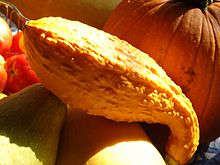
Cucurbita is a genus of herbaceous fruits in the gourd family, Cucurbitaceae, native to the Andes and Mesoamerica. Five edible species are grown and consumed for their flesh and seeds. They are variously known as squash, pumpkin, or gourd, depending on species, variety, and local parlance. Other kinds of gourd, also called bottle-gourds, are native to Africa and belong to the genus Lagenaria, which is in the same family and subfamily as Cucurbita, but in a different tribe. These other gourds are used as utensils or vessels, and their young fruits are eaten much like those of the Cucurbita species.

Spaghetti squash or vegetable spaghetti is a group of cultivars of Cucurbita pepo subsp. pepo. They are available in a variety of shapes, sizes, and colours, including ivory, yellow and orange, with orange having the highest amount of carotene. Its center contains many large seeds. When raw, the flesh is solid and similar to other raw squash. When cooked, the meat of the fruit falls away from the flesh in ribbons or strands that look like, and can be used as an alternative to, spaghetti.

Acorn squash, also called pepper squash or Des Moines squash, is a winter squash with distinctive longitudinal ridges on its exterior and sweet, yellow-orange flesh inside. Although considered a winter squash, acorn squash belongs to the same species as all summer squashes.

Cucurbita pepo is a cultivated plant of the genus Cucurbita. It yields varieties of winter squash and pumpkin, but the most widespread varieties belong to the subspecies Cucurbita pepo subsp. pepo, called summer squash.

The zucchini, courgette or baby marrow is a summer squash, a vining herbaceous plant whose fruit are harvested when their immature seeds and epicarp (rind) are still soft and edible. It is closely related, but not identical, to the marrow; its fruit may be called marrow when mature.

Calabaza is the generic name in the Spanish language for any type of winter squash. Within an English-language context it specifically refers to what is also known as the West Indian pumpkin, a winter squash typically grown in the West Indies, tropical America, and the Philippines. Calabaza is the common name for Cucurbita moschata in Cuba, Florida, Puerto Rico, and the Philippines. C. moschata is also known as auyama in Colombia, the Dominican Republic and Venezuela; ayote in Central America; zapallo in certain countries of South America; and "pumpkin", "squash", or "calabash" in English-speaking islands.
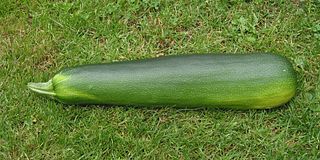
A marrow is a vegetable, the mature fruit of certain Cucurbita pepo cultivars. The immature fruit of the same or similar cultivars is called courgette or zucchini. Like courgettes, marrows are oblong, green squash, but marrows have a firm rind and a neutral flavour, making them useful as edible casings for mincemeat and other stuffings. They can be stored for several weeks after harvest, to be processed for food when required. They are a vegetable used in Great Britain and areas with significant British influence, though their popularity is waning in favor of immature summer squash like courgette.
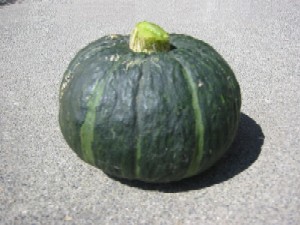
Kabocha is a type of winter squash, a Japanese variety of the species Cucurbita maxima. It is also called kabocha squash or Japanese pumpkin in North America. In Japan, "kabocha" may refer to either this squash, to the Western pumpkin, or indeed to other squashes.
Straightneck squash is a cultivated variety of Cucurbita pepo grown as a type of summer squash that is usually yellow-colored. It is also known as yellow squash, though other squashes, such as crookneck squash, may also be known by that name. It has mildly sweet and watery flesh, and thin tender skins that can be left on the fruit for many types of recipes. It was almost certainly domesticated in the eastern United States, although other variants of the same species were domesticated in Mesoamerica. This squash grows on vined plants reaching 60–90 cm (2.0–3.0 ft) in height that thrive in mild weather. It is well known as an item in American cooking where it is fried, microwaved, steamed, boiled, or baked. It is often used in recipes interchangeably with zucchini. A good yellow summer squash will be small and firm with tender skin free of blemishes and bruising. It is available all year long in some regions, but is at its peak from early through late summer. One similar inedible C. pepo variety is C. pepo var. ovifera.

Cucurbita moschata is a species originating in either Central America or northern South America. It includes cultivars known as squash or pumpkin. C. moschata cultivars are generally more tolerant of hot, humid weather than cultivars of C. maxima or C. pepo. They also generally display a greater resistance to disease and insects, especially to the squash vine borer. Commercially made pumpkin pie mix is most often made from varieties of C. moschata. The ancestral species of the genus Cucurbita were present in the Americas before the arrival of humans. Evolutionarily speaking the genus is relatively recent in origin as no species within the genus is genetically isolated from all the other species. C. moschata acts as the genetic bridge within the genus and is closest to the genus' progenitor.
Summer squash are squashes that are harvested when immature, while the rind is still tender and edible. Nearly all summer squashes are varieties of Cucurbita pepo, though not all Cucurbita pepo are considered summer squashes. Most summer squash have a bushy growth habit, unlike the rambling vines of many winter squashes. The name "summer squash" refers to the short storage life of these squashes, unlike that of winter squashes.

Delicata squash is a variety of winter squash with cream-coloured cylindrical fruits striped in green or orange that are cooked. As its name suggests, it has characteristically a delicate rind. It is also known as peanut squash, Bohemian squash, or sweet potato squash. It is a very sweet variety with a thin, edible skin and is typically cut into half rounds and roasted. It is a cultivar of the species Cucurbita pepo, which also includes the summer squash varieties pattypan squash, zucchini, and yellow crookneck squash, as well as winter squash varieties including acorn squash, spaghetti squash, and most pumpkins used as Jack-o-lanterns.

Winter squash is an annual fruit representing several squash species within the genus Cucurbita. Late-growing, less symmetrical, odd-shaped, rough or warty varieties, small to medium in size, but with long-keeping qualities and hard rinds, are usually called winter squash. They differ from summer squash in that they are harvested and eaten in the mature stage when their seeds within have matured fully and their skin has hardened into a tough rind. At this stage, most varieties of this vegetable can be stored for use during the winter. Winter squash is generally cooked before being eaten, and the skin or rind is not usually eaten as it is with summer squash.
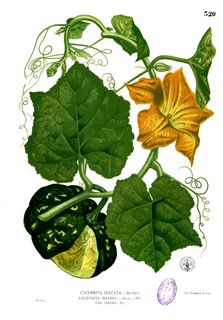
Cucurbita maxima, one of at least four species of cultivated squash, is one of the most diverse domesticated species. This species originated in South America from the wild Cucurbita andreana over 4000 years ago. The two species hybridize quite readily but have noticeably different calcium levels. Only long-vining plants are known in this species.

A pumpkin is a cultivar of winter squash that is round with smooth, slightly ribbed skin, and is most often deep yellow to orange in coloration. The thick shell contains the seeds and pulp. The name is most commonly used for cultivars of Cucurbita pepo, but some cultivars of Cucurbita maxima, C. argyrosperma, and C. moschata with similar appearance are also sometimes called "pumpkins".

Tromboncino, also known as zucchetta, is a type of squash most often used as a summer squash. While nearly all summer squash are cultivars of Cucurbita pepo, tromboncino is a cultivar of Cucurbita moschata. The vining growth habit is similar to many winter squashes, but unlike most other summer squash. It is more tolerant to some common summer squash pests, including squash vine borer, squash bugs, and powdery mildew, than the more commonly grown, bushy, C. pepo summer squash cultivars. The plants are slower to start producing than some C. pepo types. The fruit color is usually pale green, fading to beige upon maturity, and it is picked around one foot long for summer squash. It is an heirloom, originally from Liguria, and remains popular throughout Italy and abroad. Tromboncino squash can be left to mature into a winter squash; such is often compared to a watery butternut squash. If left to ripen, the fruits can grow over three feet in length. Its flesh is delicious roasted or when prepared in a stew or soup.
Cucurbita fraterna, also known as Cucurbita pepo subsp. fraterna, is a mesophyte plant species of the genus Cucurbita. It is native to Tamaulipas and Nuevo León, Mexico. It has not been domesticated. It is the progenitor and nearest relative of the domesticated species Cucurbita pepo and wild C. pepo is still found in the same areas as C. fraterna. It was formally described by Liberty Hyde Bailey in 1943, in Gentes Herbarum.

Cucurbita texana, also known as Cucurbita pepo subsp. texana and Texas gourd, is a mesophytic plant species of the genus Cucurbita. It is native to Texas, primarily the southeastern region. It is found only in the wild. It is possibly a progenitor and close relative of the domesticated species Cucurbita pepo, though it and wild C. pepo are native to different areas. Cucurbita fraterna is also closely related. It was first collected 1835 by J. L. Berlandier in southern Texas. It was formally described as Tristemon texanus by George Heinrich Adolf Scheele in 1848 and transferred to the genus Cucurbita by Asa Gray in 1850.
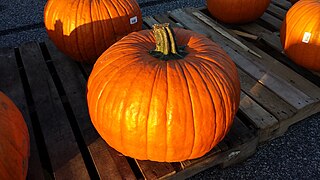
The Connecticut field pumpkin is a type of pumpkin. It is an heirloom variety, the "standard" and "classic" pumpkin, "one of the oldest pumpkins in existence". Widely used for autumn decorations, either whole or as jack-o'-lanterns, it is also suitable for culinary purposes. Said to differ little from winter squash grown by Native Americans in pre-Columbian times, the name "Connecticut field" references the area where the ancestral variety was found, as well as the traditional system of planting pumpkins in corn fields.
